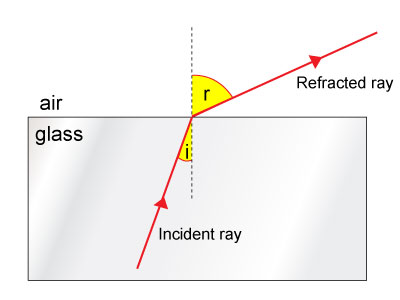Total Internal Reflection (TIR) is a phenomenon that occurs when light traveling through a medium reaches a boundary with another medium and is completely reflected into the original medium. This happens when the angle of incidence is greater than the critical angle, which is determined by the refractive indices of the two media. TIR is an important concept in optics as it allows for manipulating and controlling light, leading to various applications in different fields.
When light travels from a medium with a higher refractive index to a medium with a lower refractive index, it bends away from the normal line at the boundary between the two media. This bending of light is known as refraction. However, when the angle of incidence exceeds a certain critical angle, all of the light is reflected into the original medium instead of being refracted. This phenomenon is known as total internal reflection.
Total internal reflection is important in optics because it allows light transmission over long distances without significant loss of intensity. It is used in applications such as optical fibers, prisms, mirrors, and even natural phenomena like mirages. By understanding and harnessing total internal reflection, scientists and engineers have developed technologies that have revolutionized communication, imaging, and many other fields.

Understanding Critical Angle Formula
The critical angle is defined as the angle of incidence at which total internal reflection occurs. It can be calculated using the formula:
Critical Angle = sin^(-1)(n2/n1)
where n1 is the refractive index of the medium from which light is coming, and n2 is the refractive index of the medium into which light enters.
The derivation of this formula involves Snell’s law, which states that the ratio of the sine of the angle of incidence to the sine of the rise of refraction is equal to the balance of the refractive indices of the two media. By rearranging Snell’s law and setting the angle of refraction to 90 degrees (since total internal reflection occurs when light is reflected into the original medium), we can derive the critical angle formula.
The critical angle formula determines whether total internal reflection will occur at a boundary between two media. If the angle of incidence is greater than the acute angle, an entire internal review will appear. If the angle of incidence is less than the critical angle, refraction will occur.
Applications of Total Internal Reflection
Total internal reflection has numerous applications in optics. One of the most common applications is in reflective coatings, where a thin layer of material with a high refractive index is applied to a surface to enhance its reflectivity. This is used in mirrors, camera lenses, and other optical devices to improve performance.
Another application of total internal reflection is optical isolators, which control the direction of light propagation. Optical isolators consist of a polarizer, a Faraday rotator, and an analyzer. The Faraday rotator utilizes total internal reflection to rotate the polarization of light passing through it, allowing only light with a specific polarization to pass through.
Reflective prisms also utilize total internal reflection to redirect light. These prisms are often used in binoculars, cameras, and other optical instruments to change the direction of light without introducing significant distortion or loss of intensity.
Optical fibers are another important application of total internal reflection. They are thin strands of glass or plastic that can transmit light over long distances with minimal loss of intensity. A comprehensive internal review confines the light within the fiber’s core, preventing it from escaping.
Mirrors also rely on total internal reflection to reflect light. The reflective surface of a mirror is typically made from a material with a high refractive index, such as silver or aluminum. When light strikes the mirror at an angle greater than the critical angle, it is reflected into the original medium.
Optical Fibers and Total Internal Reflection
Optical fibers are a key application of total internal reflection. They are used in telecommunications, medical imaging, and many other fields where the transmission of light signals over long distances is required.
Optical fibers consist of a core, the central region through which light travels, and a cladding, which surrounds the body and has a lower refractive index. The body is typically made from glass or plastic, while the cladding is made from a material with a lower refractive index, such as silica.
When light enters the core of an optical fiber, it undergoes total internal reflection at the boundary between the body and the cladding. This allows the light to be transmitted through the fiber without significant loss of intensity. The light can be guided along the fiber by controlling the angle of incidence at which it enters the core.
One of the advantages of using optical fibers is their ability to transmit large amounts of information over long distances. This is due to the low loss of intensity that occurs during total internal reflection. Optical fibers also have a high bandwidth, meaning they can transmit a wide range of frequencies simultaneously.
Optical fibers have numerous applications in telecommunications, where they are used to transmit voice, data, and video signals over long distances. They are also used in medical imaging techniques such as endoscopy and fiber optic sensors for monitoring various parameters in industrial processes.
Total Internal Reflection in Prism
Prism is another important application of total internal reflection. Prisms are transparent optical elements with flat polished surfaces that can refract, reflect, and disperse light. They are often used to redirect light or to separate white light into its component colors.
Prisms utilize total internal reflection to redirect light at specific angles. When light enters a prism at an angle greater than the critical angle, it undergoes an entire internal review at the boundaries between the prism and the surrounding medium. This allows the light to be reflected and redirected within the prism.
There are several prisms, including triangular, rectangular, and pentagonal. Every prism has different angles and shapes, determining how light is refracted and reflected.
Prisms have numerous applications in optics. They are commonly used in binoculars, cameras, and other optical instruments to change the direction of light without introducing significant distortion or loss of intensity. Prisms are also used in spectroscopy to separate white light into its component colors for analysis.
Total Internal Reflection in Diamond
Diamonds are known for their brilliance and sparkle, partly due to total internal reflection. Their high refractive index causes light to undergo an entire internal review when it enters the diamond at certain angles.
Total internal reflection in diamonds is responsible for their ability to reflect and refract light in a way that creates a dazzling display of colors. This phenomenon is known as dispersion, giving diamonds their characteristic fire and brilliance.
In addition to their aesthetic appeal, diamonds have practical applications that rely on total internal reflection. Due to their hardness and ability to maintain a sharp edge, diamonds are used as cutting tools. They are also used in industrial applications such as heat sinks, radiation detectors, and high-pressure anvils.
Total Internal Reflection in Water
Total internal reflection can also occur in water, leading to interesting optical phenomena. When light travels from a medium with a higher refractive index (such as water) to a medium with a lower refractive index (such as air), it can undergo total internal reflection at the boundary between the two media.
One example of total internal reflection in water is when light strikes the water’s surface at an angle greater than the critical angle. This can create a mirror-like review on the surface of the water, known as a specular reflection.
Another example of total internal reflection in water is when light enters water from air at an angle greater than the critical angle. This can create a phenomenon known as a water-air interface, where light is trapped within a thin layer of water and appears to glow.
Total internal reflection in water has various applications. It is used in underwater photography and videography to capture images and videos of aquatic life. It is also used in optical devices such as periscopes and underwater cameras to observe objects underwater without distortion or loss of intensity.
Total Internal Reflection in Mirages
Mirages are optical illusions when light undergoes total internal reflection in the Earth’s atmosphere. They are often seen in deserts or on hot roads, with a significant temperature gradient between the ground and the air.
There are two types of mirages: inferior mirages and superior mirages. Inferior mirages occur when a layer of hot air is near the ground, causing light to bend away from the normal line and undergo total internal reflection. This creates an image of the sky or distant objects that appear to be below the actual position.
Superior mirages occur when a layer of cold air near the ground causes light to bend toward the normal line and undergo total internal reflection. This creates an image of objects that appear to be above their actual position.
Mirages have fascinated people for centuries and have been the subject of many myths and legends. They are also important in meteorology, as they can indicate atmospheric conditions such as temperature inversions and thermal gradients.
Total Internal Reflection in Microscopy
In microscopy, total internal reflection is used to study objects at high resolution and magnification. Several types of microscopy utilize entire internal review, including fluorescence microscopy, total internal reflection fluorescence microscopy (TIRFM), and evanescent wave microscopy.
Fluorescence microscopy uses fluorescent dyes or proteins to label specific structures or molecules within a sample. When the piece is illuminated with light of a particular wavelength, the labeled systems or molecules emit light of a different wavelength, which can be detected and visualized.
TIRFM is a specialized form of fluorescence microscopy that uses total internal reflection to selectively illuminate a thin layer of the sample near the surface. This allows for high-resolution imaging of structures or molecules close to the surface while minimizing background fluorescence from deeper regions.
Evanescent wave microscopy uses total internal reflection to create a passing wave, a non-propagating electromagnetic field that decays exponentially with distance from the interface. This allows for high-resolution imaging of structures or molecules within a few hundred nanometers of the surface.
Microscopy techniques that utilize total internal reflection have numerous applications in biology, medicine, and materials science. They are used to study cellular processes, protein interactions, and surface properties of materials at the nanoscale.
Future Prospects of Total Internal Reflection
Total internal reflection has revolutionized various fields, such as telecommunications, imaging, and materials science. However, many potential applications and advancements remain.
Total internal reflection technology advancements could lead to faster and more efficient communication systems. Optical fibers could be further improved to transmit even larger amounts of data over longer distances. This could have significant implications for telecommunication, internet connectivity, and data storage industries.
Total internal reflection could also be used in new types of optical devices and sensors. For example, trapping light within a thin material layer could create more efficient solar cells. It could also be used to develop new types of sensors for detecting chemicals, gases, or biological molecules.
In conclusion, total internal reflection is a fascinating phenomenon with numerous applications in optics. It allows for manipulating and controlling light, leading to advancements in communication, imaging, and many other fields. By understanding and harnessing total internal reflection, scientists and engineers have developed technologies that have revolutionized our world. With further advancements and research, the potential applications of total internal reflection are limitless.





